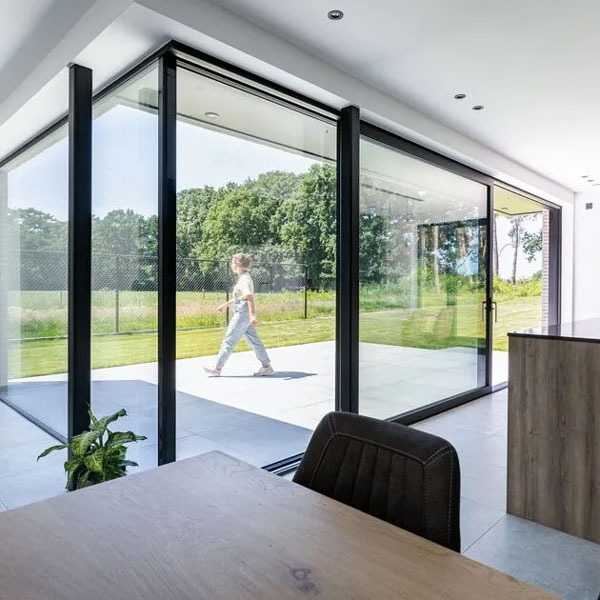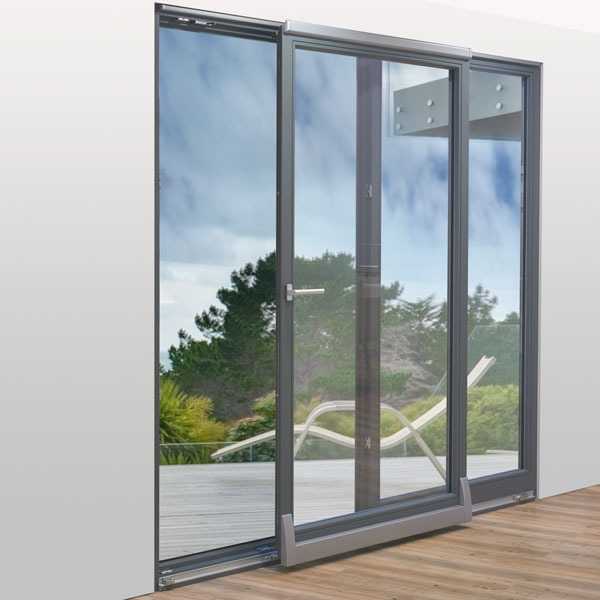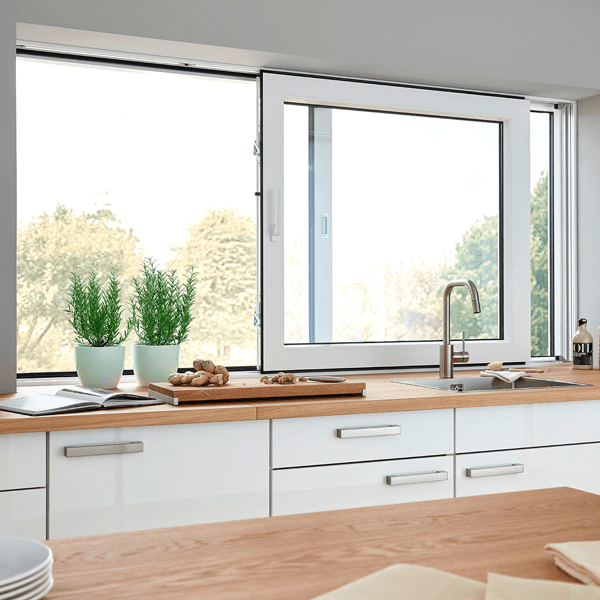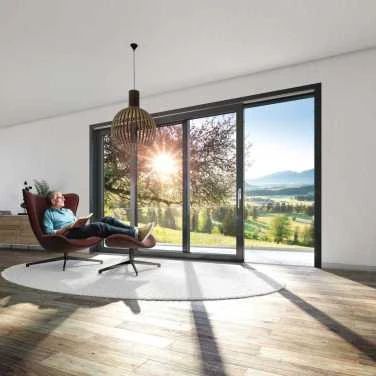
1. HS – Lift-and-Slide Doors
This is currently the most popular and most comfortable solution on the market.
How do they function?
The movable sash doesn’t swing inward like traditional balcony doors do. Instead, it slightly lifts and slides smoothly along a track parallel to the fixed part.
Key advantages:
- Flush threshold – Ultra-low (even 0 mm!) thresholds ensure barrier-free access and maximum comfort.
- Large glazing surfaces – The HS system facilitates the construction of large glass walls, perfect for contemporary architectural designs.
- Ease of operation – Even large panels slide seamlessly, frequently manageable with just one hand.
Best for:
Homeowners looking for top comfort, modern aesthetics, and panoramic glass surfaces.

2. HKS – Tilt-and-Slide Doors
A hybrid between a traditional tilt window and a sliding door system.
How do they work?
The sash first tilts inward for ventilation, then slides horizontally along a dedicated rail system.
Key advantages:
- Tilt function – offers ventilation without fully opening the door.
- Space-saving – The sash doesn’t protrude into the room like conventional balcony doors.
Drawbacks:
- Higher threshold compared to HS systems.
- Sash size limitations, not suitable for very large glazing areas.
Best for:
Individuals seeking a practical, mid-range option that offers a balance between functionality and cost.

3. PSK – Tilt-and-Slide Doors with a Recessed Sliding Mechanism
Often mistaken for HKS, yet distinct. PSK is one of the most classic sliding systems.
How do they work?
The sash tilts first, then swings outward from the frame and slides along the track using a dedicated hardware mechanism. While similar in function to HKS, it requires more manual operation and effort.
Key advantages:
- Tilt function – Provides basic ventilation.
- Good thermal performance – Thanks to tight sash compression.
- Lower cost than HS.
Drawbacks:
- Higher threshold – less user-friendly for daily use.
- More effort to operate – particularly with large or heavy sashes.
- Limited sash sizes – reduces architectural freedom compared to HS.
Best for:
Budget-conscious users who value the tilt feature and are willing to compromise on ease of use.

4. Slide – Classic Sliding Doors
The simplest and most affordable sliding door system.
How do they work?
The door sash slides along a bottom track without the lifting mechanism. Think of it as similar to a sliding wardrobe door – basic, but functional.
Key advantages:
- Lowest price – Among all sliding door systems.
- Simple construction, fewer mechanical components, less maintenance.
Drawbacks:
- Lower air-tightness – compared to HS and HKS.
- No tilt function, and typically a higher threshold.
- Less comfortable operation – may require more effort to slide.
Best for:
People with a limited budget who don't plan to use the door frequently but want larger glazing areas.
Which System Should You Choose?
Here’s a quick side-by-side comparison:
| Feature | HS | HKS | PSK | Slide |
|---|---|---|---|---|
| Ease of operation | ★★★★★ | ★★★★☆ | ★★★☆☆ | ★★★☆☆ |
| Threshold height | Ultra-low | Medium | High | High |
| Max. glazing area | Very large | Medium | Medium | Small/Medium |
| Price | High | Medium | Medium/Low | Low |
| Tilt ventilation | No | Yes | Yes | No |
Final Thoughts
Your choice between HS, HKS, PSK or Slide should depend on your expectations, usage patterns and budget.
Dreaming of vast glazing and sleek modern lines? Go with HS.
Want a functional and affordable solution? HKS might be the sweet spot.
Need a budget-friendly option that just gets the job done? Slide is your answer.
At Okno-Pol, we’ll help you find the perfect door system tailored to your needs. Contact one of our advisors to get started.
